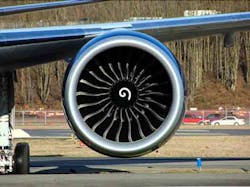GE Aviation is offering a positive assessment of its ceramic matrix composite (CMC) hot-section components for the GE9X engine, the high-bypass turbofan engines being developed for the forthcoming Boeing 777X series aircraft. The engine builder reported its tests on a GEnx demonstrator engine fitted with GE9X CMC components for the combustor and turbine exhibited impressive durability over long-term service.
The first GE9X engine tests are scheduled for next year, with flight-testing on GE’s flying testbed set for 2017. Engine certification is scheduled for 2018.
Almost 700 GE9X engines have been ordered by customers since it was adopted by Boeing for its 777-8X and -9X aircraft, the first of which are scheduled to make their debut in 2020.
“The GEnx demonstrator engine accumulated 2,800 endurance cycles at a GE test stand in Peebles, OH, and an Avio Aero test cell in Naples, Italy,” explained Bill Millhaem, general manager of the GE90/GE9X engine programs at GE Aviation. “When the engine was torn down, the CMC components were in pristine condition, further confirming the unique characteristics of CMCs.”
It’s notable that GE Aviation is already using CMC parts in jet engines. The CFM International (a GE joint venture) LEAP engines use CMC shrouds for the high-pressure turbine (HPT). The GE9X will expand CMC use to the inner and outer combustor liners, HPT stage 1 and stage 2 nozzles, and stage 1 shrouds.
The GE9X engine will be a 100,000-lb thrust commercial aircraft engine with a 134-in. diameter composite fan case and 16 carbon-fiber composite fan blades. It will have 27:1 pressure-ratio 11-stage high-pressure compressor; a third-generation TAPS III combustor, for high efficiency and low emissions; and CMC material in the combustor and turbine.
CMCs are formed with silicon-carbide (SiC) ceramic fibers in a SiC matrix, and then coated with proprietary ceramic material. GE’s Global Research Centers and industrial businesses have been developing commercial applications for CMCs for over two decades.
GE’s jet engine-building business has called ceramic matrix composites “a critical pathway on GE Aviation’s technology roadmap,” principally because of the “ultra lightweight” and heat-resistant potential: they are one-third as dense as metal alloys, bringing valuable weight reduction that adds to aircraft fuel efficiency, and the heat-resistance is seen as enhancing engine performance, durability, and fuel economy.
“Since CMCs are far more heat-resistant than metal alloys, they require less cooling air in the engine’s hot section. This air instead can be used in the engine flow path, enabling it to run more efficiently,” the developer explained.
GE Aviation called the successful hot-section application for CMCs “a breakthrough” for the jet propulsion.
The GEnx CMC demonstrator engine also validated parts for the GE9X made from other materials, including 3D-printed titanium aluminide (TiAl) low-pressure turbine blades produced by Avio Aero; and HPT stage 1 blades with an advanced cooling circuit, developed at GE Aviation’s Cores & Castings facility in Dayton, OH.
Testing of CMC parts is continuing. The GEnx demonstrator engine will be rebuilt and run with the same combustor liners, HPT stage 1 shrouds and HPT stage 2 nozzles, LPT TiAl blades and the next-gen HPT blades along with the addition of HPT stage 1 nozzles. A GE9X core with CMC components in the combustor and HPT will begin testing in October.
About the Author
Robert Brooks
Content Director
Robert Brooks has been a business-to-business reporter, writer, editor, and columnist for more than 20 years, specializing in the primary metal and basic manufacturing industries.
